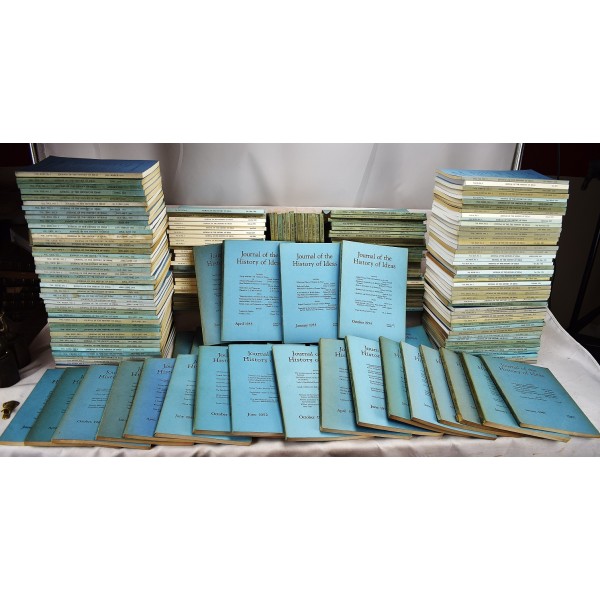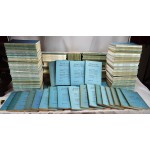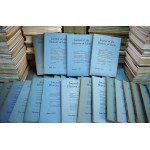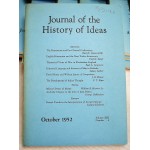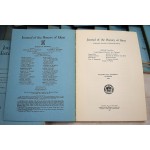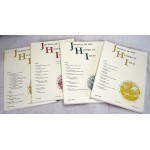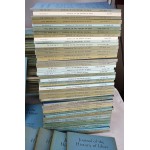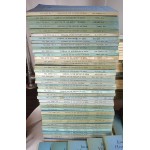Journal of the History of Ideas: A Quarterly Devoted to Intellectual History (186 Volume Set)
Journal of the History of Ideas: A Quarterly Devoted to Intellectual History (186 Volume Set)
A.O. Lovejoy (Editor); Bertand Russell; John Dewey; Richard Hofstadter; Jacques Barzun, Paul Tillich; Gilbert Chinard; Ernst Cassirer; George Boas; Hans Kohn; Marjorie H. Nicolson; Arnold J. Toynbee; John H. Randall Jr.; Richard McKeon; Solomon Simonson; Ernest A. Moody; Harold Cherniss; Tony Tanner; Keny Emery Jr.; Diane B. Paul; Cameron Shelley; Robert Carr; Brian Tierney; Felix Gilbert; Walter Grossman; Maurice Mandelbaum; Philip P. Wiener
City College of New York, 1940
[A massive collection of 186 volumes from the library of noted scholar Richard A. Macksey, two of which are signed by George Boas.] Printed 1940-2003. Softcover. Good bindings and covers. Shelf wear. Spines sunned. Occasional tear. Some foxing. Generally clean, with some markings by Macksey. <br> Important articles in this collection include: Reflection on the History of Ideas by Arthur O. Lovejoy; Grundtvig's Philosophy of History by Kemp Malone; Experience and the Non-Mathematical in the Cartesian Method by Alan Gewirtz; Causation and its Application to History by Morris R. Cohen; Existential Philosophy by Paul Tillich; Gulliver and the Moons of Mars by S.H. Gould; Bookburning and Censorship in Ancient Rome by F.H. Cramer; A.O. Lovejoy as Historian of Philosophy by George Boas; The Function of Myth in Plato's Philosophy by Ludwig Edelstein; Nationalist Survival Under Hellenistic and Roman Imperialism by Moses Hadas; Treason and Patriotism in Ancient Greece by Anton-Hermann Chroust; Voltaire's Philosophy of History by Jerome Rosenthal; Nietzsche's Theory of Decadence and the Transvaluation of all Values by George de Huszar; Aristotle's Conception of the Development and the Nature of Scientific Method by Richard McKeon; The Chinese Mind: Its Taoist Substratum by Lin Tung-Chi; Seven Agamemnons by Reuben A. Brower; Galileo and Avempace (I) by Ernest A. Moody; Discussion of Suicide in the 18th Century by Lester G. Crocker; Newton and God by Edward Strong; Mars and Engels as Historians by Leonard Krieger; Leonardo Da Vinci and Modern Science by John H. Randall Jr.; Stoic Idea of Natural Law by Maryanne Cline Horowitz; Galileo's Theory of Indivisibles by A. Mark Smith; Marxist Ecclesiology and Biblical Criticism by Julius Kovesi; Hume on Idolatry and Incarnation by Donald T. Siebert; Eugenics and the Left by Diane B. Paul; Ancient Psychotherapy by Christopher Gill; The Influence of Folk Meteorology in the Anaximander Fragment by Cameron Shelley; In Memory of A.O. Lovejoy by Ludwig Edelstein; On Dante, Hyperspheres, and the Curvature of the Medieval Cosmos by William Egginton; Zen and the Art of Death by Maja Milcinski; The Plot of History from Antiquity to the Renaissance by Eric MacPhail; Zino Against Mathematical Physics by Trish Glazebrook; Montesquieu on Depopulation by David B. Young; Ancient Greek Dialectic as Expression of Freedom of Thought and Speech by Enrico Berti; Scientific Background of Evolutionary Theory in Biology by Maurice Mandebaum; The Salvation of Satan by C.A. Patrides; The Mystical Origins of National Socialism by George L. Mosse; Poetic Inspiration in Greek Literature by E.N. Tigerstedt; Women in Greek and Pauline Thought by Alan Cumming.
Contents: Vol. I, No. 1, Jan. 1940; Vol. I, No. 3, Jun. 1940; Vol. I, No. 4, Oct. 1940; Vol. II, No. 1, Jan. 1941; Vol. II, No. 2, Apr. 1941; Vol. II, No. 4, Oct. 1941; Vol. III, No. 1, Jan. 1942; Vol. III, No. 2, Apr. 1942; Vol. III, No. 3, Jun. 1942; Vol. IV, No. 1, Jan. 1943; Vol. IV, No. 2, Apr. 1943; Vol. IV, No. 3, Jun. 1943; Vol. IV, No. 4, Oct. 1943; Vol. V, No. 1, Jan. 1944; Vol. V, No. 3, Jun. 1944; Vol. V, No. 4, Oct. 1944; Vol. VI, No. 1, Jan. 1945; Vol. VI, No. 2, Apr. 1945; Vol. VI, No. 3, Jun. 1945; Vol. VI, No. 4, Oct. 1945; Vol. VII, No. 1, Jan. 1946; Vol. VII, No. 4, Oct. 1946; Vol. VIII, No. 1, Jan. 1947; Vol. VIII, No. 2, Apr. 1947; Vol. VIII, No. 3, Jun. 1947; Vol. VIII, No. 4, Oct. 1947; Vol. IX, No. 1, Jan. 1948; Vol. IX, No. 2, Apr. 1948; Vol. IX, No. 3, Jun. 1948; Vol. IX, No. 4, Oct. 1948; Vol. X, No. 1, Jan. 1949; Vol. X, No. 2, Apr. 1949; Vol. X, No. 4, Oct. 1949; Vol. XI, No. 1, Jan. 1950; Vol. XI, No. 2, Apr. 1950; Vol. XI, No. 3, Jun. 1950; Vol. XI, No. 4, Oct. 1950; Vol. XII, No. 1, Jan. 1951; Vol. XII, No. 2, Apr. 1951; Vol. XII, No. 3, Jun. 1951; Vol. XII, No. 4, Oct. 1951; Vol. XIII, No. 1, Jan. 1952; Vol. XIII, No. 2, Apr. 1952; Vol. XIII, No. 3, Jun. 1952; Vol. XIII, No. 4, Oct. 1952; Vol. XIV, No. 1, Jan. 1953; Vol. XIV, No. 2, Apr. 1953; Vol. XIV, No. 3, Jun. 1953; Vol. XIV, No. 4, Oct. 1953; Vol. XV, No. 1, Jan. 1954; Vol. XV, No. 2, Apr. 1954; Vol. XV, No. 3, Jun. 1954; Vol. XV, No. 4, Oct. 1954; Vol. XVI, No. 1, Jan. 1955; Vol. XVI, No. 2, Apr. 1955; Vol. XVI, No. 3, Jun. 1955; Vol. XVI, No. 4, Oct. 1955; Vol. XVII, No. 1, Jan. 1956; Vol. XVII, No. 2, Apr. 1956; Vol. XVII, No. 3, Jun. 1956; Vol. XVII, No. 4, Oct. 1956; Vol. XVIII, No. 1, Jan. 1957; Vol. XVIII, No. 2, Apr. 1957; Vol. XVIII, No. 4, Jun. 1957; Vol. XVIII, No. 4, Oct. 1957; Vol. XIX, No. 1, Jan. 1958; Vol. XIX, No. 2, Apr. 1958; Vol. XIX, No. 3, Jun. 1958; Vol. XIX, No. 4, Oct. 1958; Vol. XX, No. 1, Jan. 1959; Vol. XX, No. 2, Apr. 1959; Vol. XXI, No. 4, Oct.-Dec. 1960; Vol. XXII, No. 1, Jan.-Mar. 1961; Vol. XXII, No. 2, Apr.-Jun. 1961; Vol. XXII, No. 3, Jul.-Sep. 1961; Vol. XXII, No. 4, Oct.-Dec. 1961; Vol. XXIII, No. 1, Jan.-Mar. 1962; Vol. XXIII, No. 2, Apr.-Jun. 1962; Vol. XXIII, No. 3, Jul-Sep. 1962; Vol. XXIII, No. 4, Oct.-Dec. 1962; Vol. XXIV, No. 1, Jan.-Mar. 1963; Vol. XXIV, No. 2, Apr.-Jun. 1963; Vol. XXIV, No. 3, Jul.-Sep. 1963; Vol. XXIV, No. 4, Oct.-Dec. 1963; Vol. XXV, No. 2, Apr.-Jun. 1964; Vol. XXV, No. 3, Jul.-Sep. 1964; Vol. XXV, No. 4, Oct.-Dec. 1964; Vol. XXVI, No. 1, Jan.-Mar. 1965; Vol. XXVI, No. 2, Apr.-Jun. 1965; Vol. XXVI, No. 3, Jul.-Sep. 1965; Vol. XXVI, No. 4, Oct.-Dec. 1965; Vol. XXVII, No. 1, Jan.-Mar. 1966; Vol. XXVII, No. 2, Apr.-Jun. 1966; Vol. XXVII, No. 3, Jul.-Sep. 1966; Vol. XXVII, No. 4, Oct.-Dec. 1966; Vol. XXVIIII, No. 1, Jan.-Mar. 1967; Vol. XXVIIII, No. 2, Apr.-Jun. 1967; Vol. XXVIIII, No. 3, Jul.-Sep. 1967; Vol. XXVIII, No. 4, Oct.-Dec. 1967; Vol. XXIX, No. 1, Jan.-Mar. 1968; Vol. XXIX, No. 2, Apr.-Jun. 1968; Vol. XXIX, No. 3, Jul.-Sep. 1968; Vol. XXIX, No. 4, Oct.-Dec. 1968; Vol. XXX, No. 1, Jan.-Mar. 1969; Vol. XXX, No. 2, Apr.-Jun. 1969; Vol. XXX, No. 3, Jul.-Sep. 1969; Vol. XXX, No. 4, Oct.-Dec. 1969; Vol. XXXI, No. 1, Jan.-Mar. 1970; Vol. XXXI, No. 2, Apr.-Jun. 1970; Vol. XXXI, No. 3, Jul.-Sep. 1970; Vol. XXXI, No. 4, Oct.-Dec. 1970; Vol. XXXII, No. 1, Jan.-Mar. 1971; Vol. XXXII, No. 2, Apr.-Jun. 1971; Vol. XXXII, No. 3, Jul.-Sep. 1971; Vol. XXXII, No. 4, Oct.-Dec. 1971; Vol. XXXIII, No. 1, Jan.-Mar. 1972; Vol. XXXIII, No. 2, Apr.-Jun. 1972; Vol. XXXIII, No. 3. Jul.-Sep. 1972; Vol. XXXIII, No. 4, Oct.-Dec. 1972; Vol. XXXIV, No. 1, Jan.-Mar. 1973; Vol. XXXIV, No. 2, Apr.-Jun. 1973; Vol. XXXIV, No. 3, Jul.-Sep. 1973; Vol. XXXIV, No. 4, Oct.-Dec. 1973; Vol. XXXV, No. 1, Jan.-Mar. 1974; Vol. XXXV, No. 2, Apr.-Jun. 1974; Vol. XXXV, No. 3, Jul.-Sep. 1974; Vol. XXXV, No. 4, Oct.-Dec. 1974; Vol. XXXVI, No. 1, Jan.-Mar. 1975; Vol. XXXVI, No. 2, Apr.-Jun. 1975; Vol. XXXVI, No. 3, Jul.-Sep. 1975; Vol. XXXVI, No. 4, Oct.-Dec. 1975; Vol. XXXVII, No.1, Jan.-Mar. 1976; Vol. XXXVII, No. 2, Apr.-Jun. 1976; Vol. XXXVII, No. 3, Jul.-Sep. 1976; Vol. XXXVII, No. 4, Oct.-Dec. 1976; Vol. XXXVIII, No. 1, Jan.-Mar. 1977; Vol. XXXVIII, No.2, Apr.-Jun. 1977; Vol. XXXVIII, No. 4, Oct.-Dec. 1977; Vol. XXXIX, No. 1, Jan.-Mar. 1978; Vol. XXXIX, No. 2, Apr.-Jun. 1978; Vol. XXXIX, No. 3, Jul.-Sep. 1978; Vol. XXXIX, No. 4, Oct.-Dec. 1978; Vol. XL, No. 1, Jan.-Mar. 1979; Vol. XL, No. 2, Apr.-Jun. 1979; Vol. XL, No. 3, Jul.-Sep. 1979; Vol. XL, No. 4, Oct.-Dec. 1979; Vol. XLI, No. 1, Jan.-Mar. 1980; Vol. XLI, No. 2, Apr.-Jun. 1980; Vol. XLI, No. 3, Jul.-Sep. 1980; Vol. XLI, No. 4, Oct.-Dec. 1980; Vol. XLII, No. 1, Jan.-Mar. 1981; Vol. XLII, No. 2, Apr.-Jun. 1981; Vol. XLIV, No. 3, Jul.-Sep. 1983; Vol. XLIV, No. 4, Oct.-Dec. 1983; Vol. XLV, No. 1, Jan.-Mar. 1984; Vol. XLV, No. 2, Apr.-Jun. 1984; Vol. XLV, No. 3, Jul.-Sep. 1984; Vol. XLV, No. 4, Oct.-Dec. 1984; Vol. XLVI, No. 1, Jan.-Mar. 1985; Vol. XLVI, No. 2, Apr.-Jun. 1985; Vol. XLVI, No. 3, Jul.-Sep. 1985; Vol. XLVI, No. 4, Oct.-Dec. 1985; Vol. XLVII, No. 1, Jan.-Mar. 1986; Vol. XLVII, No. 2, Apr.-Jun. 1986; Vol. XLVII, No. 3, Jul.-Sep. 1986; Vol. XLVII, No. 4, Oct.-Dec. 1986; Vol. 60, No. 1, Jan. 1999; Vol. 60, No. 2, Apr. 1999; Vol. 60, No. 3, Jul. 1999; Vol. 60, No. 4, Oct. 1999; Vol. 61, No. 1, Jan. 2000; Vol. 61, No. 2, Apr. 2000; Vol. 61, No. 3, Jul. 2000; Vol. 61, No. 4, Oct. 2000; Vol. 62, No. 1, Jan. 2001; Vol. 62, No. 2, Apr. 2001; Vol. 62, No. 3, Jul. 2001; Vol. 62, No. 4, Oct. 2001; Vol. 63, No. 1, Jan. 2002; Vol. 63, No. 2, Apr. 2002; Vol. 63, No. 3, Jul. 2002; Vol. 63, No. 4, Oct. 2002; Vol. 64, No. 2, Apr. 2003; Vol. 64, No. 3, Jul. 2003; Cumulative Index Volumes I-XXV (1940-1964); Cumulative Index Volumes XXVI-XXX (1965-1969); Cumulative Index Volumes XLVI-LXI (1985-2000).
"Richard A. Macksey was a celebrated Johns Hopkins University professor whose affiliation with the university spanned six and a half decades. A legendary figure not only in his own fields of critical theory, comparative literature, and film studies but across all the humanities, Macksey possessed enormous intellectual capacity and a deeply insightful human nature. He was a man who read and wrote in six languages, was instrumental in launching a new era in structuralist thought in America, maintained a personal library containing a staggering collection of books and manuscripts, inspired generations of students to follow him to the thorniest heights of the human intellect, and penned or edited dozens of volumes of scholarly works, fiction, poetry, and translation." - Johns Hopkins University
Arthur O. Lovejoy (1873-1962) was a leading philosopher, historian of ideas, and public intellectual in the first half of the twentieth century. He is perhaps best known today for his role in establishing the principles of academic freedom (through his work in founding the AAUP) and for founding the Journal of the History of Ideas. He was Professor of Philosophy at Johns Hopkins from 1910 to 1938, and continued to write and be active in the History of Ideas Club until his death in 1962. From 1915 to 1940 he was second in stature within American philosophy only to John Dewey, and while he is mainly studied today by intellectual historians, his early work on pragmatism and philosophy of mind follows an analytic method that has aged quite well. The Great Chain of Being (1936) remains an acknowledged classic in the history of ideas.
Since its inception in 1940, the Journal of the History of Ideas has served as a medium for the publication of research in intellectual history that is of common interest to scholars and students in a wide range of fields. It is committed to encouraging diversity in regional coverage, chronological range, and methodological approaches. JHI defines intellectual history expansively and ecumenically, including the histories of philosophy, of literature and the arts, of the natural and social sciences, of religion, and of political thought. It also encourages scholarship at the intersections of cultural and intellectual history, for example, the history of the book and of visual culture.
This is an oversized or heavy book, which requires additional postage for international delivery outside the US.
